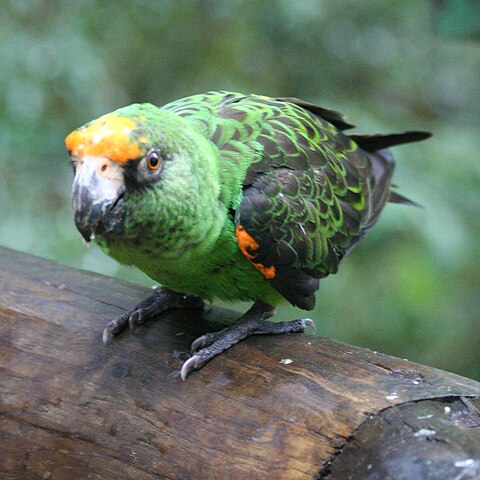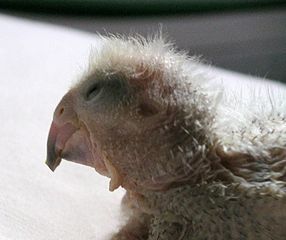Despite clear evidence that African Gray Parrots (Psittacus erithacus) are declining in the 23 countries to which they are native, conservation horror stories continue to mount. Recently, for example, 750 parrots died on board an airplane in South Africa, and the government of the Democratic Republic of Congo returned 500+ wild-caught birds to smugglers. So it was a pleasure to read that Uganda has recently taken a giant step forward in parrot conservation. For the first time ever, African Gray Parrots seized in Europe have been returned to the wild. The historic 3-year effort also illustrated an unprecedented degree of cooperation between governments, zoos, airlines and conservation organizations.
Can 32 Birds Make a Difference?
Conservationists estimate that at least ¼ of the adult population of wild African Gray Parrots are trapped each year. The return of 32 birds to the wild in Uganda may, therefore, seem to be insignificant. However, I believe that the operation’s value goes well beyond the number of birds that were rescued.
For too long, wildlife criminals have operated with near impunity once they managed to get parrots and other African wildlife out of the continent. Cooperation with unscrupulous officials in Africa and abroad, and the inability of under-funded law enforcement agencies to compete, have kept convictions low and penalties inconsequential. Uganda’s dogged determination to see justice done has recently broken new ground, and has hopefully set a standard for neighboring countries to follow.
A Conservation “First”
The parrots in question were illegally trapped in Uganda in 2010. They were routed through Lebanon and were eventually seized in Bulgaria. Uganda has a history of releasing confiscated wildlife, but no African country has ever been able to locate, seize and return to the wild parrots that have been shipped to another continent. The costs are prohibitive, and expertise in the laws of several countries, and in international law, is essential. In addition, a core group of people must be in place long term, as even where there is no question that the birds were illegally removed from the wild, the process usually takes several years (over 3, in this instance).
In this case, everything came together in a way that has not been seen in the past. Financial assistance was provided by Qatar Airlines and the World Parrot Trust, and the government of Bulgaria cooperated with that of Uganda throughout. The Sofia Zoo held the parrots for a time and screened them for diseases before the release was approved. The parrots were re-habituated to the wild at the Ngamba Chimpanzee Sanctuary and then released on Ngamba Island.
Continuing Threats to African Gray and Other Parrots
Despite the fact that wild-caught adult parrots make notoriously poor pets, demand remains high. In addition, numerous chicks are collected, often by felling nest-bearing trees. Nesting hollows are a scarce commodity in parrot habitats, and their destruction seriously impedes the breeding success of the resident parrot population. Other African Psittacines, including the Red-Fronted Parrot (Poicephalus gulielmi, please see photo), also remain at risk despite local and international protections. In recent years, Uganda has confiscated many parrots destined for European markets; 204 African Grays were released to the wild in 2011.

Image originally posted to Wikipedia by Poicephalus_gulielmi_-Birds_of_Eden_-South_Africa-8a.jpg: Graham
You can read more about African Gray Parrot conservation and natural history in the articles linked above and below. Unfortunately, bad news is still the norm, and many people here in the USA are unaware of the scope of the problem (as wild-caught parrots have long been illegal to import or own)…please post any information you may come across below.
 That Bird Blog – Bird Care and History for Pet Birds
That Bird Blog – Bird Care and History for Pet Birds





Hello Frank: Do you have a reference for the claim that 1/4 of adult population of African greys are captured each year? I would love to see that. I’ve been searching for info like to show the high probability of African greys going extinct in our lifetimes. Michael Ostrogorsky
Hi Michael,
Thanks for your interest; figure is from an IUCN assessment; scroll down to Conservation Status here.; Further IUCN info
here
Good luck, pl keep me posted, Frank
Thank you Frank! Exactly what I needed.
I don’t hear that so often! Glad it was useful, pl keep me posted on your efforts..
Dear Frank, thank you for sharing the story of this project that was initiated by the World Parrot Trust over 3 years ago.
I would just like to clarify that it’s not known where the parrots had been trapped. Most likely in the Democratic Republic of Congo or Nigeria, but nobody knows for sure. The Uganda authorities have been extremely generous in accepting to rehabilitate and release these birds. We are hearing that they are doing very well and have already been visited by wild Greys passing by Ngamba Island.
It is also important to point out that it’s not just the illegal trade that it’s threatening this species, but also the legal trade allowing export quotas that are not scientifically justified and are often exceeded.
Much appreciated, Christina, thank you. Best regards, Frank
I love parrots and I had an African Gray which I adore. I agree with the release back into the wild but I also have to say that, injured birds that wont survive in the wild should be put up for adoption so they could have a second chance in life with a good love and care, they are very affectionate and funny.
High fines should be place for all those who are involve with the smuggler situation as for airlines, governments, buyers all the chain that goes with it and not just for parrots but for all our precious wildlife.
Hi maria,
Thanks for your interest and concern, Best, Frank
Hi Maria,
Thanks for your thoughts and concern,
Enjoy, Frank
Heartbreaking but at least there are a few rays of sunshine. As much as I love birds, I really don’t think they should be kept as pets. They deserve to fly free and not shut away in cages.
Hey there, I think your website might be having browser compatibility issues.
When I look at your blog site in Safari, it looks fine but when opening in
Internet Explorer, it has some overlapping. I just wanted to give you a quick heads
up! Other then that, superb blog!
Hi, Thanks for contacting us. I’m not seeing any issues in Internet Explorer (on PC, no access to MAC). Can you send us a screenshot or give additional details (what version of the browser you’re using). Send any additional information to blogs@thatpetplace.com and we will do our best to address the information!
Thanks, That Pet Blog